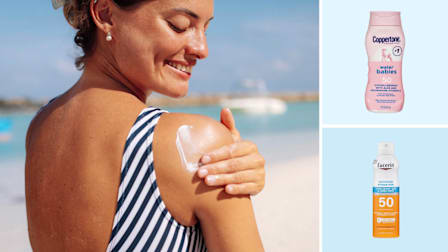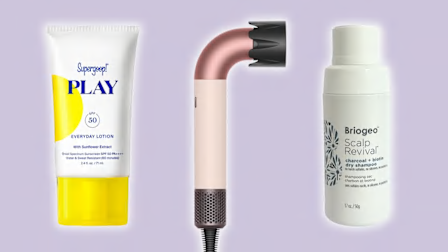5 Reasons You Should Wear Sunscreen Every Day Year-Round
No matter what the calendar says, you shouldn't shelve sun protection until next Memorial Day
When you shop through retailer links on our site, we may earn affiliate commissions. 100% of the fees we collect are used to support our nonprofit mission. Learn more.

There’s still debate in the fashion world about whether it’s OK to wear white after Labor Day. But when it comes to sunscreen, there’s no room for argument. Sun protection needs to be part of your everyday routine year-round. So even if you shove your white jeans to the back of the closet, make sure you leave your sunscreen handy this fall (winter and spring too).
1. You’re Getting Sun Exposure Even When You Think You’re Not
We all know to slather on sunscreen for a day on the beach, a long hike, or time on the pickleball court. But it’s easy to forget about it when you’re doing less-summery activities. That can include taking a walk at lunchtime, raking leaves, or running errands. “We get most of our sun damage at off times when you’re not thinking about it and didn’t plan for it,” says Nghiem. “Like running into a friend in the grocery store parking lot and talking for 15 minutes.” Depending on your skin type, that can be plenty of time to rack up some sun damage regardless of the time of year.
2. Temperature Doesn’t Matter When It Comes to UV Rays
It’s easy to equate damage to your skin from the sun with heat from the sun (after all, it is called a sunburn). But air temperature and the strength of the sun’s ultraviolet rays aren’t always linked. That’s why you want to be aware of the UV Index.
“Temperature is a measure of how hot it is, while the UV index is a measure of how strong the UV rays are,” says Joshua Zeichner, M.D., associate professor of dermatology and director of cosmetic and clinical research in dermatology at Mount Sinai Hospital in New York.
It is true that in the summer, high temperatures and high UV index numbers tend to go hand in hand. But a lot of factors go into the UV index—including your location, altitude, and cloud cover. Looking at that number gives you a more accurate indication of how much you should worry about the sun. “Temperature can be confusing and sometimes misleading,” says Nghiem. “You could be freezing on a ski slope and still get a wicked sunburn.” Regardless of the time of year, the strength of UV rays increases by 2 percent for every 1,000 feet of elevation. So if you live at sea level and you’re hanging out at the restaurant atop a 10,000-foot ski mountain, the sun is 20 percent stronger than you’re used to.
Most weather apps list the UV index. A reading of 1 or 2 is Low, 3 to 5 is Moderate, 6 to 7 is High, 8 to 10 is Very High, and 11 or more is Extreme. You can also search for the UV index at any location in the U.S. on the EPA’s website, or download the agency’s UV index app.
3. Seasonal Shifts Aren’t the Same Everywhere
No matter where you live, you’ll see less sunlight during the fall, winter, and spring than you do in the summer. But, depending on where you are, those shorter days can still deliver a surprising amount of sun damage. It’s common sense to some degree—if you live in Miami Beach, the sun is much stronger year-round than it is in the far northern regions of Maine. Geography also dictates how much time you might spend outdoors in non-summer months. It stands to reason that those of you in Miami Beach are a lot more likely to eat lunch on a park bench 12 months out of the year than those who call Maine home. And more time outside means more cumulative sun exposure.
4. Your Face Is Always on Display
No matter the time of year, your face is the one part of your body that rarely gets a break from the sun. Not surprisingly, your face also shows signs of aging—lines, dark spots, sagging—sooner and is more susceptible to skin cancer than less-exposed body parts. That’s why you need to stay diligent about applying sunscreen to your face 365 days a year. Find a facial moisturizer with an SPF 30 or higher and make it part of your daily routine. And while you’re at it, spread a little onto your neck and the backs of your hands too since they also get more than just summertime sun exposure.
5. Making Sunscreen a Habit Can Save Your Life
About 90 percent of skin cancers, including the potentially fatal melanoma, are linked to sun exposure. The strength of UVA rays—which play a big role in the formation of skin cancer as well as skin aging—is more consistent year-round than the burning UVB rays. “Even low levels of UV exposure from daily activity add up over a lifetime,” says Ziechner. “Think of putting on sunscreen the same way you think about brushing your teeth,” he says. “If you forget to brush one day, your teeth will be okay, but if you stop brushing your teeth for several months of the year, you’ll pay the price.” The same is true for skipping sunscreen throughout fall, winter, and spring.
Top Sunscreens From CR's Tests
These sunscreens—the top lotion, spray, and facial products from our ratings of more than 115 products—provide great protection.
































